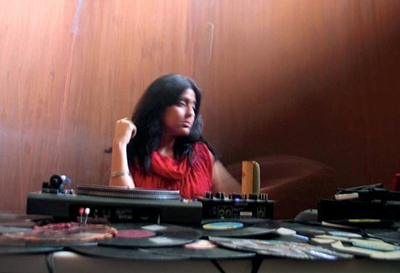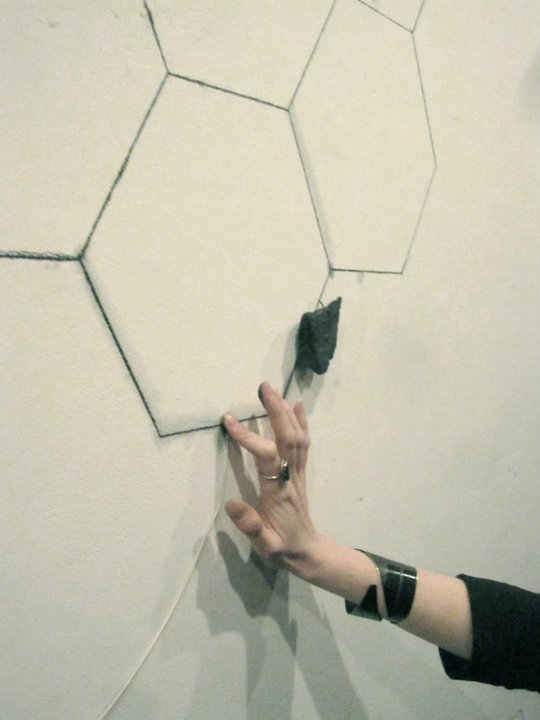I came across the name of Maria Chavez for the first time last July when going through the program of the Christian Marclay Festival (Whitney Museum of American Art, July 1- September 26 2010). It was only a matter of time to see Maria perform live in one of the many events happening in town. Her intuitive, interactive, reactive way of treating her materials, vinyl records and needles for that matter, impressed me. She is also one of the few female artists, if not the only one, in town who manages to bend the turntablist rules effortlessly and create immersive sonic atmospheres made of sparse samples, clicks and scratches. And these are only a few of the reasons that motivated me to do this interview with her. Maria was born in Peru, lived in Houston and is now based in Brooklyn. She is currently curating a series of shows entitled Dead Of Winter Works at the Splatterpool Gallery showcasing new work by Richard Garet, Shelley Burgon, David Linton, Byron Westbrook, Future Archaeology and Sarah Lipstate. I have asked her a few things about her relationship to vinyl, her working process, about the NY scene and about fashion.
You do an extensive use of record needles, or pencils of sound as you call them, to draw abstract improvised sonic patterns over vinyl records. How did you end up working/experimenting with vinyl?
I started as a house music DJ. Mainly focusing on French Disco House. The process of converting vinyl into a more dissected sound opportunity happened by chance. I was required to attend an improvisation music class in order to get credits for my Audio Engineering degree. The teacher of the class, David Dove, an abstract trombonist, who later became my first mentor, asked me to bring one turntable. Just to see what would happen. Once I heard the first fragmented sound, I knew that my primary focus was to create and utilize a vocabulary derived from that moment.
Do you feel like a collector when it comes to your relationship with vinyl?
I don’t think I am the regular definition of a collector mainly because I do not go out in search of records very often. In a lot of cases, the records find me. Like when you brought me these Greek spoken word and traditional songs records. That’s how most of my collection has been built. I, also, don’t have sleeves for my vinyl. They all go through a regular change, TOGETHER, in my backpack. The constant change of my regular vocabulary, the vinyl rubbing against each other in the backpack, is important for me. It helps remind me of present moment during performance.
There are some sound sources, nonetheless, that I do treasure, like a collector, that stay in their sleeves until I feel that they are ready to be amongst my vocabulary. When that happens, I can’t answer, because it’s always so different. I want to make sure that my relationship with chance has a process that all of my materials go through.
Which of the following better describes your creative process: composing or performing?
I feel that these two actions have similar definitions in my work. So to pick one isn’t possible. So here are my definitions of both:
Composing- In the present tense of composing. Allowing accidents to compose the present moment, rather than my own ideas. I feel my ideas have more room to grow amongst accidents.
Performing- the actions taken during a live performance can create accidental situations that I must always be alert for. Therefore, my original ideas at the beginning of a piece will always be allowed to become something else completely different.
Christian Marclay is one of my favorite artists and one of the first who liberated the vinyl record from its singular use as a music entertainment medium. Last year you were invited to perform his piece entitled SCREENPLAY at the Christian Marclay Festival, along with Marina Rosenfeld and Tristan Sheperd. Did you find it challenging to follow the onscreen musical score?
It was definitely a different approach, as far as responding to visual cues. But I feel as if working on SCREENPLAY for the amount of times that I performed it (14 in all!!!) helped me to cultivate this other area of my work.
You have shared the stage with some of the most prominent figures of the experimental scene such as Pauline Oliveros and Thurston Moore. Could you please tell us a few words about how these collaborations occurred?
I worked as an Audio engineering intern for the Pauline Oliveros Foundation, which had a branch in Houston. That’s also where she is from. My very first, live, improvised music performance was in her mother’s piano studio. Pauline has become an incredibly influential woman in my life. She has shown me how much the world can give you if you give yourself to the world.
Thurston and I met on my very first East Coast tour with Christina Carter. It was my first time in NYC and we got to the venue late (driving in from Montreal). I barely remember performing with him. It happened so fast. It was all a bit too much. But he was a professional and very sweet. I hold him in the highest esteem.
What’s your view on NYC’s current experimental art scene? Do you feel that it is open enough to accept artists from any ethnic background, gender etc?
I see a lot more people involved that are really young and that’s exciting. And a lot of my peers are starting to receive more access to create larger projects. Some places are Closed, some people move, grants get created and deleted. But somehow the experimental scene in NYC is vibrant in diversity, gender and ideas for the 21st Century.
What is your relationship to fashion?
I used to own a men’s vintage clothing store in Williamsburg, Brooklyn. It was sort of like a vintage gallery. Now I collect vintage for myself. It’s an interesting and new way to think about myself rather than the demographic my store was geared towards. But I feel that everything that I am interested in is approached in a similar manner. Fashion to me, is another outlet for me to express myself.
Do you have any favorite clothing shops in NY and “local” fashion blogs, magazines?
Alter, Jumelle, Malin Landaeus Vintage, Electric Feather, Bona Drag, Fluke Vintage
Artist Website: mariachavez.org




 RSS
RSS
